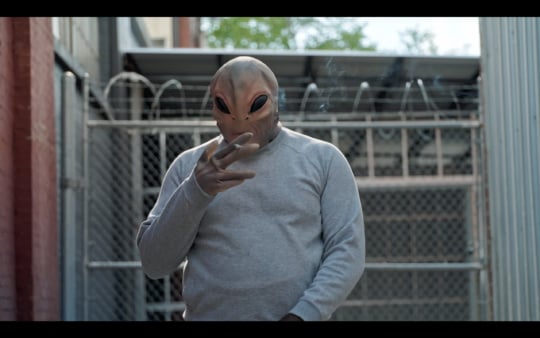Click the video above to watch the trailer for A Dangerous Method (© 2011 Sony Pictures Classics).
David Cronenberg’s A Dangerous Method tells the story of an utterly bizarre and thrillingly original romantic triangle: a female patient, her analyst, and the ideas of psychoanalysis that fill their conversations, forming a slightly perverse troika of repression and unburdening.
When the film opens, Sabina Spielrein (Keira Knightley) arrives at Swiss psychiatrist Carl Jung’s Zurich clinic in 1904 in a disturbed, disheveled state. She is carried into the hospital raving. In her first session with Jung, her body brutally spasms beneath the burden of some repressed trauma. Her limbs seizing up and her chin jutting, Spielrein is as frightening and deformed as anything in Cronenberg’s kit bag of human flies and mutating bodies. Spielrein is a Russian Jewish aristocrat with a domineering father whose punishments have been formative. Spielrein at first appears to be the iconic female hysteric of Victorian medicine’s legend, a woman driven mad and compromised by some unspecified female deficiency.

A Dangerous Method shows the crushing, punishing burden of any form of sexual desire in a woman: Spielrein is literally deformed by it. But the psychoanalytic “talking cure” as practiced by Jung becomes the liberating force that allows for a cure, as well as Spielrein’s trading of sexual repression for expression.
On the opposite end of the spectrum of acceptable female sexuality is Jung’s wife Emma (Sarah Gadon). Delicate, submissive, and devoted to her husband, Emma apologizes for her unappealing pregnant body and begs Jung’s forgiveness for giving him daughters instead of sons. If Emma defines healthy and well-adjusted femininity, Cronenberg and writer Christopher Hampton clearly prefer Spielrein’s fully human, uncontrollable, complex life force.
In this highly speculative treatise on the birth of psychoanalysis and the real-life influence of Sigmund Freud, Carl Jung, and Sabina Spielrein on its methods, Cronenberg allows history to intermingle with his own artistic preoccupations. Though often seen as a pawn between Jung and Freud, Spielrein emerges as fully human in Knightley’s hands. For her part, the vastly underrated, intelligent Knightley brings this uncommon woman’s brilliance and spirit beautifully alive. A Dangerous Method crafts a fascinating, tragic heroine from a woman history has overlooked.

Jung is played by the art cinema’s current erotic icon, Michael Fassbender, who has made his mark playing predatory older men clocking vulnerable young things in Fish Tank and sex addicts trolling New York for some action in Shame, the debut film by British visual artist and Turner Prize winner Steve McQueen. Fassbender offers a believable mix of his stock in trade angst and ardor in the figure of Carl Jung. Jung resists a growing attraction to Spielrein, a luscious combination of brilliance, vulnerability, and sexual adventurism.
But his real downfall comes when his much-admired Viennese mentor Sigmund Freud refers a dangerously self-involved analyst and free-love advocate Otto Gross (the art cinema’s resident sexy pervert Vincent Cassel) to Jung for treatment. Like a cartoon devil whispering dangerous ideas into Jung’s ear, Gross’s unbridled, I’ve-got-to-be-me lifestyle and his belief in bedding anything that moves pushes Jung away from propriety. The kind of brilliant but sinister force you don’t want getting into your brain (à la Hannibal Lechter), Gross nevertheless bores away and convinces Jung that not sleeping with Spielrein would be a denial of the same unburdening expression that psychoanalysis preaches.

As a science in formation, psychoanalysis in A Dangerous Method is a malleable thing: it can seem to excuse people like Gross as he flings off social constraints. And it can also demand an intellectual remove from its analysts that seems chilly and far from the flesh-and-blood suffering of their patients. A Dangerous Method is a film that titillates and provokes by moving between those poles of hot and cold, passionate and restrained. It is that tension that gives the film its peculiar tone and is very much in keeping with the usual rhythms of Cronenberg’s body of work. Though more often known for his chilly, stylish, and utterly contemporary marriages of sex and violence—such as in his films Eastern Promises, A History of Violence, and Crash—A Dangerous Method is in keeping with a Cronenbergian fascination with the violence, lust, and fury that are capable of bursting forth from the placid mirage of normal life.
Spielrein soon transforms, under Jung’s care, from a hopelessly damaged woman into a brilliant aspiring psychiatrist in her own right. The agent of her transformation is the psychoanalytic “talking cure” and deep exploration with Jung of the source of her malady. She longs to contribute to the field of psychoanalysis that has aided in her recovery.
If Freud is the better-known figure in psychoanalytic history, Cronenberg makes Jung—because of his involvement with Spielrein—the more fascinating figure. As the elder statesman of the subconscious, Freud has trouble letting go of his power, even with his colleague Jung. He staunchly guards the reputation of his science, becoming agitated when upstart Jung begins explorations into mysticism, the supernatural, and other methods Freud feels could undermine psychoanalysis’s acceptance. Freud’s unwillingness to explore their discipline on equal footing is magnified by the class divide that separates the economically struggling Freud and the wealthy Jung. Freud chafes at the money Jung has married into and how his prominence is imperiled by Jung’s economic might.

Despite all of the conflict between two approaches to psychoanalysis in the end, A Dangerous Method hinges on that melodramatic constant, the impossible romance. Despite their intellectual compatibility and sexual chemistry, Jung and Spielrein spin away from each other. Within his cocoon of perversity, Cronenberg is often an intensely romantic director who depicts a conjoining of intellect and sex that finds the height of human connection in their intermingling. An enduringly intellectual filmmaker, Cronenberg is also long interested in upsetting the power hierarchy that places men on top and women below. Spielrein and Jung flip flop between positions of strength and weakness and between a desire for freedom and the tethers of social propriety.
Like Cronenberg, whose films have also often fixated on characters desiring ecstasy, transformation, and escape, Spielrein’s contribution to psychoanalysis was a certainty that human consciousness is defined by both the urge for life and for death. Spielrein might have been Freud and Jung’s muse, but she is also Cronenberg’s. Spielrein is presented as a slightly magical and revolutionary figure for escaping her family trauma and occupying both sides of the psychoanalytic coin as both patient and analyst. And she is also the key to Cronenberg’s fascinations, which encompass both obliteration and a brutal urge to find transformation in destruction.
A Dangerous Method is currently on view in Atlanta at United Artists Tara Cinema at 2345 Cheshire Bridge Road.
Felicia Feaster is an Atlanta editor and writer who worked, most recently, as the senior editor at The Atlantan. Her writing has appeared in Creative Loafing, Elle, Playboy.com, Atlanta magazine, Art in America, ART PAPERS, Sculpture, and the Atlanta Journal-Constitution.
Ciné 1.0 is a look at cinema history and cinema present, delving into the at times overlooked or forgotten but nevertheless thought-provoking, artful films that have impacted world culture and altered our perception of life and art.




